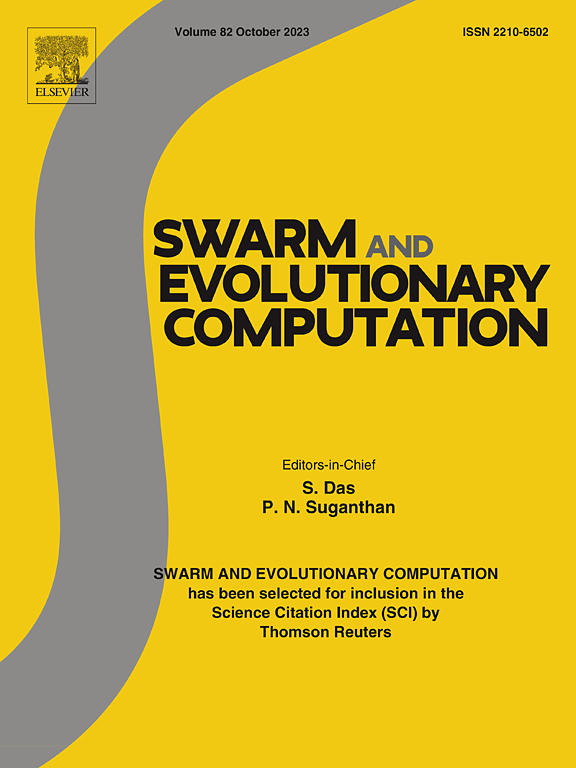混合服务器上的并行遗传算法:性能和能源的设计、实现和优化
IF 8.5
1区 计算机科学
Q1 COMPUTER SCIENCE, ARTIFICIAL INTELLIGENCE
引用次数: 0
摘要
并行遗传算法(PGAs)已被广泛应用于加速解决现实世界中的问题,如建筑结构中的能源优化、数据挖掘中的数据预处理和模型选择步骤、电子产品中的多电平逆变器的实时控制、土地利用规划、纳米科学、电力系统中的最优潮流和道路交通管理。最先进的研究提出,PGAs仅针对性能和解决多核CPU、GPU或多核CPU集群上的优化问题进行优化。然而,目前还没有研究对异构混合平台的PGAs进行分析,这些平台包括并行利用所有计算设备的多核cpu和多个加速器。此外,没有明确的比较研究全面调查混合系统中PGAs与多核cpu或gpu的能耗。我们在这项工作中解决了上述现有技术中的空白。首先,我们提出了一种为异构混合平台量身定制的新型并行化方法(HPIGA),具有利用所有可用计算设备(包括多核cpu和gpu)的可移植实现。我们对这种方法的性能和能源概况进行了全面的调查。我们将其与其他三种传统并行方法进行了比较,从100个维度到5000个维度不等。结果表明,与研究中其他传统方法相比,HPIGA具有竞争力的能耗行为和良好的性能。此外,我们提出了一个双目标优化问题的PGA采用并行岛模型和执行的混合服务器包含p个计算设备。这个问题有两个目标:性能和能量。在我们的双目标优化问题中使用的决策变量是工作量分配,它与岛屿的数量成正比。我们研究了PGA在Intel冰岛多核CPU和两个Nvidia A40 gpu的混合服务器平台上的效率,分析了两种功率调控下的执行时间和动态能量分布。由此产生的帕累托前沿图提供了有价值的见解,作为未来开发和使用各种计算设备的高效、节能优化技术的关键基准。本文章由计算机程序翻译,如有差异,请以英文原文为准。
Parallel genetic algorithms on hybrid servers: Design, implementation, and optimization for performance and energy
Parallel Genetic Algorithms (PGAs) have been widely applied to accelerate solutions for real-world problems such as energy optimization in building constructions, data preprocessing and model selection steps in data mining, real-time control of multilevel inverters in electronics, land-use planning, nanoscience, optimal power flow in power systems, and road traffic management.
The state-of-the-art research proposes PGAs optimized solely for performance and for solving optimization problems on a multicore CPU, GPU, or clusters of multicore CPUs. However, no research has analyzed PGAs for heterogeneous hybrid platforms comprising multicore CPUs and multiple accelerators that utilize all computing devices in parallel. Furthermore, no definitive comparative research comprehensively investigates the energy consumption of PGAs in hybrid systems versus multicore CPUs or GPUs.
We address the above gaps in the prior art in this work. First, we present a novel parallelization approach (HPIGA) tailored for heterogeneous hybrid platforms, featuring a portable implementation that utilizes all available computational devices, including multicore CPUs and GPUs. We conduct a comprehensive investigation into the performance and energy profiles of this approach. We compare it with three other traditional parallel approaches across a range of dimensions, varying from 100 dimensions and up to 5000 dimensions. The results showed HPIGA’s competitive energy consumption behavior and promising performance compared to other traditional approaches under the study.
Moreover, we formulate a bi-objective optimization problem of a PGA employing a parallel island model and executing on a hybrid server comprising compute devices. The problem has two objectives: performance and energy. The decision variable used in our bi-objective optimization problem is workload distribution, which is proportional to the number of islands. We study the efficacy of our proposed PGA on a hybrid server platform with an Intel Icelake multicore CPU and two Nvidia A40 GPUs, analyzing execution time and dynamic energy profiles under two power governors. The resulting Pareto front graphs provide valuable insights, serving as crucial benchmarks for the future development and use of efficient, energy-aware optimization techniques across diverse computational devices.
求助全文
通过发布文献求助,成功后即可免费获取论文全文。
去求助
来源期刊

Swarm and Evolutionary Computation
COMPUTER SCIENCE, ARTIFICIAL INTELLIGENCEC-COMPUTER SCIENCE, THEORY & METHODS
CiteScore
16.00
自引率
12.00%
发文量
169
期刊介绍:
Swarm and Evolutionary Computation is a pioneering peer-reviewed journal focused on the latest research and advancements in nature-inspired intelligent computation using swarm and evolutionary algorithms. It covers theoretical, experimental, and practical aspects of these paradigms and their hybrids, promoting interdisciplinary research. The journal prioritizes the publication of high-quality, original articles that push the boundaries of evolutionary computation and swarm intelligence. Additionally, it welcomes survey papers on current topics and novel applications. Topics of interest include but are not limited to: Genetic Algorithms, and Genetic Programming, Evolution Strategies, and Evolutionary Programming, Differential Evolution, Artificial Immune Systems, Particle Swarms, Ant Colony, Bacterial Foraging, Artificial Bees, Fireflies Algorithm, Harmony Search, Artificial Life, Digital Organisms, Estimation of Distribution Algorithms, Stochastic Diffusion Search, Quantum Computing, Nano Computing, Membrane Computing, Human-centric Computing, Hybridization of Algorithms, Memetic Computing, Autonomic Computing, Self-organizing systems, Combinatorial, Discrete, Binary, Constrained, Multi-objective, Multi-modal, Dynamic, and Large-scale Optimization.
 求助内容:
求助内容: 应助结果提醒方式:
应助结果提醒方式:


